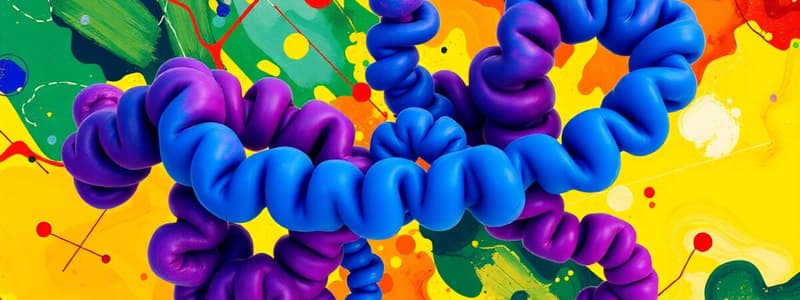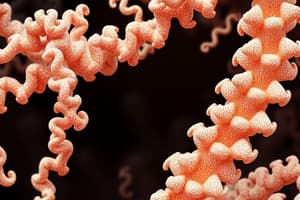Podcast
Questions and Answers
What are post translational modifications primarily responsible for?
What are post translational modifications primarily responsible for?
- Modifying proteins after translation (correct)
- Creating peptide bonds in proteins
- Initiating transcription of DNA
- Catalyzing the synthesis of amino acids
Which type of bonds predominantly assist proteins in maintaining their shape during folding?
Which type of bonds predominantly assist proteins in maintaining their shape during folding?
- Metallic bonds
- Hydrogen bonds (correct)
- Covalent bonds
- Ionic bonds
Which amino acid property influences their orientation during protein folding?
Which amino acid property influences their orientation during protein folding?
- Hydrophobicity only
- Frequency of occurrence
- Molecular weight
- Charge and polarity (correct)
What is the effect of polar amino acid side chains in protein structures?
What is the effect of polar amino acid side chains in protein structures?
Which process is NOT considered a post translational modification?
Which process is NOT considered a post translational modification?
What characterizes the noncovalent bonds that help proteins fold?
What characterizes the noncovalent bonds that help proteins fold?
How do long polypeptide chains contribute to protein folding?
How do long polypeptide chains contribute to protein folding?
Which of the following modifications is a form of proteolytic processing?
Which of the following modifications is a form of proteolytic processing?
What type of linkage is formed when myristoyl is attached to a protein?
What type of linkage is formed when myristoyl is attached to a protein?
What distinguishes prenylation from acylation in protein modifications?
What distinguishes prenylation from acylation in protein modifications?
Which statement about GPI anchors is true?
Which statement about GPI anchors is true?
What happens to Ras proteins that lose their palmitoyl group?
What happens to Ras proteins that lose their palmitoyl group?
Which fatty acyl group is more commonly attached to C-terminal cysteines?
Which fatty acyl group is more commonly attached to C-terminal cysteines?
What characterizes farnesylation in protein modifications?
What characterizes farnesylation in protein modifications?
How does the presence of the carbohydrate moiety affect GPI-anchored proteins?
How does the presence of the carbohydrate moiety affect GPI-anchored proteins?
What is the primary function of the lipid modifications of proteins discussed?
What is the primary function of the lipid modifications of proteins discussed?
What happens to the immature glycoprotein after it is synthesized?
What happens to the immature glycoprotein after it is synthesized?
Which type of glycoconjugate modification may involve the addition or removal of monosaccharides?
Which type of glycoconjugate modification may involve the addition or removal of monosaccharides?
Which of the following modifications can alter protein function?
Which of the following modifications can alter protein function?
Which domains specifically recognize acetylated lysines?
Which domains specifically recognize acetylated lysines?
What are the residues that are primarily phosphorylated in proteins?
What are the residues that are primarily phosphorylated in proteins?
Which modification is fundamental in JAK-STAT signaling?
Which modification is fundamental in JAK-STAT signaling?
What kind of proteins are JAKs in the context of the JAK-STAT pathway?
What kind of proteins are JAKs in the context of the JAK-STAT pathway?
What is the overall effect of ligand binding in the JAK-STAT pathway?
What is the overall effect of ligand binding in the JAK-STAT pathway?
What type of bond forms between adjacent cysteine side chains?
What type of bond forms between adjacent cysteine side chains?
In bacteria, which oxidoreductase is responsible for catalyzing disulfide bond formation?
In bacteria, which oxidoreductase is responsible for catalyzing disulfide bond formation?
Where do sulfhydryl oxidoreductases, such as protein disulfide isomerases (PDIs), primarily operate in eukaryotic cells?
Where do sulfhydryl oxidoreductases, such as protein disulfide isomerases (PDIs), primarily operate in eukaryotic cells?
What is the role of DsbB in the disulfide bond formation process in bacteria?
What is the role of DsbB in the disulfide bond formation process in bacteria?
What do sorting motifs in proteins serve to identify?
What do sorting motifs in proteins serve to identify?
Which option describes a feature of sorting motifs?
Which option describes a feature of sorting motifs?
Which of the following processes facilitates the transfer of reducing equivalents to oxygen during aerobic growth in bacteria?
Which of the following processes facilitates the transfer of reducing equivalents to oxygen during aerobic growth in bacteria?
Which proteins are responsible for reducing PDIs in yeast during disulfide bond formation?
Which proteins are responsible for reducing PDIs in yeast during disulfide bond formation?
What is the role of ubiquitin in protein degradation?
What is the role of ubiquitin in protein degradation?
Which enzyme is responsible for the ATP-dependent attachment of ubiquitin to the ubiquitin-activating enzyme (E1)?
Which enzyme is responsible for the ATP-dependent attachment of ubiquitin to the ubiquitin-activating enzyme (E1)?
Which part of the ubiquitin protein forms the peptide bond with the lysine side chain of the target protein?
Which part of the ubiquitin protein forms the peptide bond with the lysine side chain of the target protein?
What is the role of chaperone proteins during protein translocation?
What is the role of chaperone proteins during protein translocation?
How does the nuclear localization sequence (NLS) facilitate nuclear import?
How does the nuclear localization sequence (NLS) facilitate nuclear import?
What distinguishes different types of polyubiquitin chains?
What distinguishes different types of polyubiquitin chains?
What potential effects do post-translational modifications have on proteins?
What potential effects do post-translational modifications have on proteins?
What initiates the release of the imported protein from the nuclear import receptor?
What initiates the release of the imported protein from the nuclear import receptor?
What is required for proteins to exit the nucleus?
What is required for proteins to exit the nucleus?
Which of the following is NOT a type of post-translational modification mentioned?
Which of the following is NOT a type of post-translational modification mentioned?
What happens during ubiquitin chain elongation?
What happens during ubiquitin chain elongation?
Which process is involved in making some polypeptides biologically active?
Which process is involved in making some polypeptides biologically active?
What is the main function of the proteasome in the context of ubiquitin?
What is the main function of the proteasome in the context of ubiquitin?
What role does Ran-GTP play in the export of proteins from the nucleus?
What role does Ran-GTP play in the export of proteins from the nucleus?
What happens to the protein during its translocation through the translocon?
What happens to the protein during its translocation through the translocon?
What is the significance of the signal sequence in protein translocation?
What is the significance of the signal sequence in protein translocation?
Flashcards
Post-Translational Modification (PTM)
Post-Translational Modification (PTM)
Changes made to a protein after its translation by ribosomes is complete. These modifications are catalyzed by enzymes and can include adding functional groups, proteolytic processing, and folding processes.
What are some examples of PTMs?
What are some examples of PTMs?
Examples include phosphorylation, neddylation, ubiquitination, proteolytic processing, and protein folding.
What are the components of a protein?
What are the components of a protein?
Proteins are made up of amino acids connected by peptide bonds, forming a polypeptide chain.
What are peptide bonds?
What are peptide bonds?
Signup and view all the flashcards
Why are proteins flexible?
Why are proteins flexible?
Signup and view all the flashcards
What are noncovalent bonds?
What are noncovalent bonds?
Signup and view all the flashcards
How do protein folds depend on amino acids?
How do protein folds depend on amino acids?
Signup and view all the flashcards
What is the significance of protein folding?
What is the significance of protein folding?
Signup and view all the flashcards
Disulfide Bond
Disulfide Bond
Signup and view all the flashcards
Disulfide Bond Formation
Disulfide Bond Formation
Signup and view all the flashcards
DsbA
DsbA
Signup and view all the flashcards
DsbB
DsbB
Signup and view all the flashcards
PDIs
PDIs
Signup and view all the flashcards
Ero1p and Erv2p
Ero1p and Erv2p
Signup and view all the flashcards
Sorting Motif
Sorting Motif
Signup and view all the flashcards
What does a sorting motif do?
What does a sorting motif do?
Signup and view all the flashcards
Protein Translocation
Protein Translocation
Signup and view all the flashcards
Translocon
Translocon
Signup and view all the flashcards
Nuclear Localization Sequence (NLS)
Nuclear Localization Sequence (NLS)
Signup and view all the flashcards
Nuclear Import Receptor
Nuclear Import Receptor
Signup and view all the flashcards
Ran Protein
Ran Protein
Signup and view all the flashcards
Nuclear Export Signal (NES)
Nuclear Export Signal (NES)
Signup and view all the flashcards
Polypeptide Cleavage
Polypeptide Cleavage
Signup and view all the flashcards
What is acylation?
What is acylation?
Signup and view all the flashcards
Glycoprotein Modification
Glycoprotein Modification
Signup and view all the flashcards
Where does acylation occur?
Where does acylation occur?
Signup and view all the flashcards
N-acetyl-glucosamine
N-acetyl-glucosamine
Signup and view all the flashcards
Mannose
Mannose
Signup and view all the flashcards
What is prenylation?
What is prenylation?
Signup and view all the flashcards
Glucose
Glucose
Signup and view all the flashcards
Where does prenylation occur?
Where does prenylation occur?
Signup and view all the flashcards
What's a GPI anchor?
What's a GPI anchor?
Signup and view all the flashcards
Protein Phosphorylation
Protein Phosphorylation
Signup and view all the flashcards
What's the role of a GPI anchor?
What's the role of a GPI anchor?
Signup and view all the flashcards
Protein Acetylation
Protein Acetylation
Signup and view all the flashcards
Protein Methylation
Protein Methylation
Signup and view all the flashcards
What are the main types of protein lipid modifications?
What are the main types of protein lipid modifications?
Signup and view all the flashcards
SH2 domain
SH2 domain
Signup and view all the flashcards
What's the importance of protein lipid modifications?
What's the importance of protein lipid modifications?
Signup and view all the flashcards
Ubiquitin
Ubiquitin
Signup and view all the flashcards
Proteasome
Proteasome
Signup and view all the flashcards
Ubiquitination
Ubiquitination
Signup and view all the flashcards
E1, E2, E3 Enzymes
E1, E2, E3 Enzymes
Signup and view all the flashcards
Polyubiquitin Chain
Polyubiquitin Chain
Signup and view all the flashcards
Phosphorylation
Phosphorylation
Signup and view all the flashcards
Ubiquitination vs. Phosphorylation
Ubiquitination vs. Phosphorylation
Signup and view all the flashcards
Study Notes
Post Translational Process
- Post-translational modifications (PTMs) are changes to a protein after its translation by ribosomes is complete.
- These modifications are catalyzed by enzymes.
- PTMs include adding functional groups to a protein covalently.
- Examples of PTMs include phosphorylation, neddylation, ubiquitination, proteolytic processing, and folding.
- These processes are essential for a protein to mature functionally.
Post Translational Modifications (PTM)
- Proteins are made of amino acids linked together.
- Amino acids have side chains that give them unique characteristics.
- Some side chains are nonpolar and hydrophobic (repel water).
- Other side chains are polar or charged (interact with water).
Protein Folding
- Long polypeptide chains are flexible, and can fold in numerous ways.
- Noncovalent interactions maintain the folded shape: hydrogen bonds, electrostatic attractions, and van der Waals forces.
- Polar amino acid side chains tend to lie towards the outside of proteins where they interact with water.
- Nonpolar amino acid side chains are inside the protein to avoid water interactions.
- Chaperones assist proper folding by preventing premature folding, aiding in correctly folding, and assisting in the unfolding of proteins if they fold incorrectly.
- Co-translational folding is assisted by ribosome-associated chaperones, such as Hsp70 (DnaK) and Hsp60 (GroES + GroEL).
Disulfide Bond Formation
- Disulfide bonds (S-S bonds) are covalent bonds that form between two cysteine residues.
- These bonds are critical for protein folding and stabilization.
- They can link parts of the same polypeptide chain or different polypeptide chains.
Protein Sorting Motifs
- Protein localization is determined by unique amino acid sequences (sorting motifs or sorting signals).
- Sorting motifs direct proteins to their proper locations within the cell.
- Sorting motifs can be located at the N-terminus, C-terminus, or both of a protein.
General Protein Translocation Mechanism
- Sorting motifs can be recognized by receptors, often during or after protein synthesis.
- If necessary, proteins are unfolded by chaperones to allow movement through the membrane.
- The protein is then threaded through the translocon in the membrane or pulled across by chaperones.
Protein Transport in/out of the Nucleus
- The nuclear localization sequence (NLS) directs proteins into the nucleus.
- Nuclear import receptors bind to NLS and transport the protein across the nuclear pore complex.
- GTP hydrolysis by Ran protein facilitates release of the imported protein from the receptor.
- Export receptors and nuclear export signals (NES) direct proteins out of the nucleus.
Post-translational Cleavage of Polypeptide Chain
- Some polypeptides need to be cleaved to become active.
- Enzymes (like proteases) cleave polypeptides at specific amino acid locations.
- Examples include chymotrypsin, which is initially produced as the inactive precursor chymotrypsinogen.
- Self-excising domains (inteins) can be removed from proteins.
Lipid Modifications of Protein
- Covalent attachment of lipid groups targets proteins to membranes.
- Examples include acylation (attachment of fatty acyl groups), prenylation (attachment of isoprenoid groups), and glycosylphosphatidylinositol (GPI) anchoring.
Glycosylation of Proteins
- Glycosylation is the addition of carbohydrate groups (glycans) to proteins.
- Glycosylation can alter protein solubility, stability, and interactions with other molecules.
- Glycosylation sites are often on the outside of proteins in contact with the cell environment.
Protein Phosphorylation, Acetylation, and Methylation
- Phosphorylation, acetylation, and methylation are covalent modifications to proteins that alter their activity and function.
- Phosphorylation involves attaching phosphate groups to serine, threonine, or tyrosine residues.
- Acetylation involves adding an acetyl group to lysine residues.
- Methylation involves adding methyl groups to lysine or arginine residues.
- Specific domains are recognized for each modification type.
Ubiquitination of Proteins
- Ubiquitination is the covalent attachment of ubiquitin proteins to target proteins.
- This can mark proteins for degradation, regulation, or other cellular functions.
- Different types of ubiquitin modifications can lead to different cellular outcomes.
- Ubiquitination steps involve enzymes E1, E2, and E3.
Studying That Suits You
Use AI to generate personalized quizzes and flashcards to suit your learning preferences.




